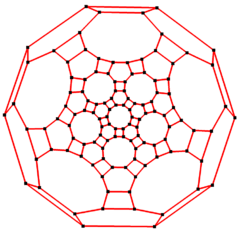Polyhedral graph


In geometric graph theory, a branch of mathematics, a polyhedral graph is the undirected graph formed from the vertices and edges of a convex polyhedron. Alternatively, in purely graph-theoretic terms, the polyhedral graphs are the 3-vertex-connected planar graphs.
Characterization
The Schlegel diagram of a convex polyhedron represents its vertices and edges as points and line segments in the Euclidean plane, forming a subdivision of an outer convex polygon into smaller convex polygons. It has no crossings, so every polyhedral graph is also a planar graph. Additionally, by Balinski's theorem, it is a 3-vertex-connected graph.
According to Steinitz's theorem, these two graph-theoretic properties are enough to completely characterize the polyhedral graphs: they are exactly the 3-vertex-connected planar graphs. That is, whenever a graph is both planar and 3-vertex-connected, there exists a polyhedron whose vertices and edges form an isomorphic graph.[1][2] Given such a graph, a representation of it as a subdivision of a convex polygon into smaller convex polygons may be found using the Tutte embedding.[3]
Hamiltonicity and shortness
Tait conjectured that every cubic polyhedral graph (that is, a polyhedral graph in which each vertex is incident to exactly three edges) has a Hamiltonian cycle, but this conjecture was disproved by a counterexample of W. T. Tutte, the polyhedral but non-Hamiltonian Tutte graph. If one relaxes the requirement that the graph be cubic, there are much smaller non-Hamiltonian polyhedral graphs; the one with the fewest vertices and edges is the 11-vertex and 18-edge Herschel graph,[4] and there also exists an 11-vertex non-Hamiltonian polyhedral graph in which all faces are triangles, the Goldner–Harary graph.[5]
More strongly, there exists a constant α < 1 (the shortness exponent) and an infinite family of polyhedral graphs such that the length of the longest simple path of an n-vertex graph in the family is O(nα).[6][7]
Combinatorial enumeration
Duijvestijn provides a count of the polyhedral graphs with up to 26 edges;[8] The number of these graphs with 6, 7, 8, ... edges is
- 1, 0, 1, 2, 2, 4, 12, 22, 58, 158, 448, 1342, 4199, 13384, 43708, 144810, ... (sequence A002840 in OEIS).
One may also enumerate the polyhedral graphs by their numbers of vertices: for graphs with 4, 5, 6, ... vertices, the number of polyhedral graphs is
- 1, 2, 7, 34, 257, 2606, 32300, 440564, 6384634, 96262938, 1496225352, ... (sequence A000944 in OEIS).
Special cases
A polyhedral graph is the graph of a simple polyhedron if it is cubic (every vertex has three edges), and it is the graph of a simplicial polyhedron if it is a maximal planar graph. The Halin graphs, graphs formed from a planar embedded tree by adding an outer cycle connecting all of the leaves of the tree, form another important subclass of the polyhedral graphs.
References
- ↑ Lectures on Polytopes, by Günter M. Ziegler (1995) ISBN 0-387-94365-X , Chapter 4 "Steinitz' Theorem for 3-Polytopes", p.103.
- ↑ Grünbaum, Branko (2003), Convex Polytopes, Graduate Texts in Mathematics 221 (2nd ed.), Springer-Verlag, ISBN 978-0-387-40409-7.
- ↑ Tutte, W. T. (1963), "How to draw a graph", Proceedings of the London Mathematical Society 13: 743–767, doi:10.1112/plms/s3-13.1.743, MR 0158387.
- ↑ Weisstein, Eric W., "Herschel Graph", MathWorld..
- ↑ Weisstein, Eric W., "Goldner-Harary Graph", MathWorld..
- ↑ Weisstein, Eric W., "Shortness Exponent", MathWorld..
- ↑ Grünbaum, Branko; Motzkin, T. S. (1962), "Longest simple paths in polyhedral graphs", Journal of the London Mathematical Society, s1-37 (1): 152–160, doi:10.1112/jlms/s1-37.1.152.
- ↑ Duijvestijn, A. J. W. (1996), "The number of polyhedral (3-connected planar) graphs", Mathematics of Computation 65: 1289–1293, doi:10.1090/S0025-5718-96-00749-1.